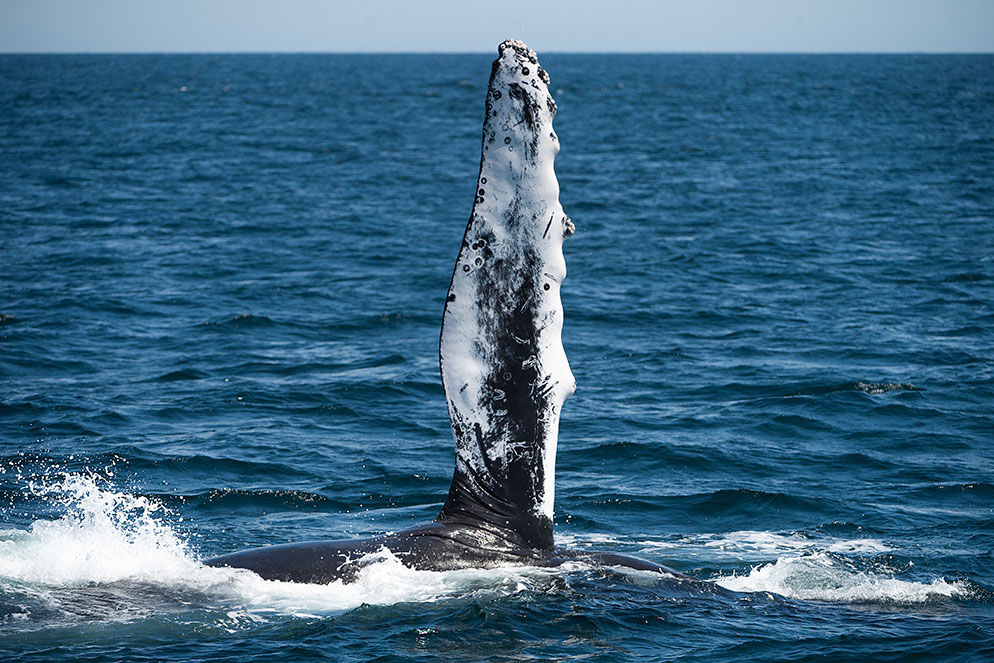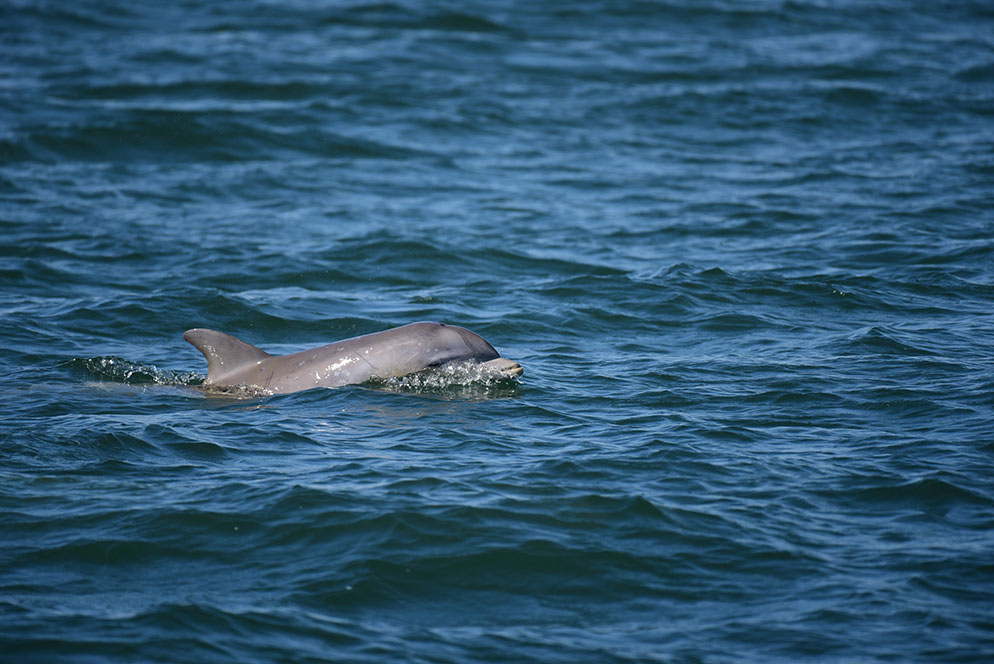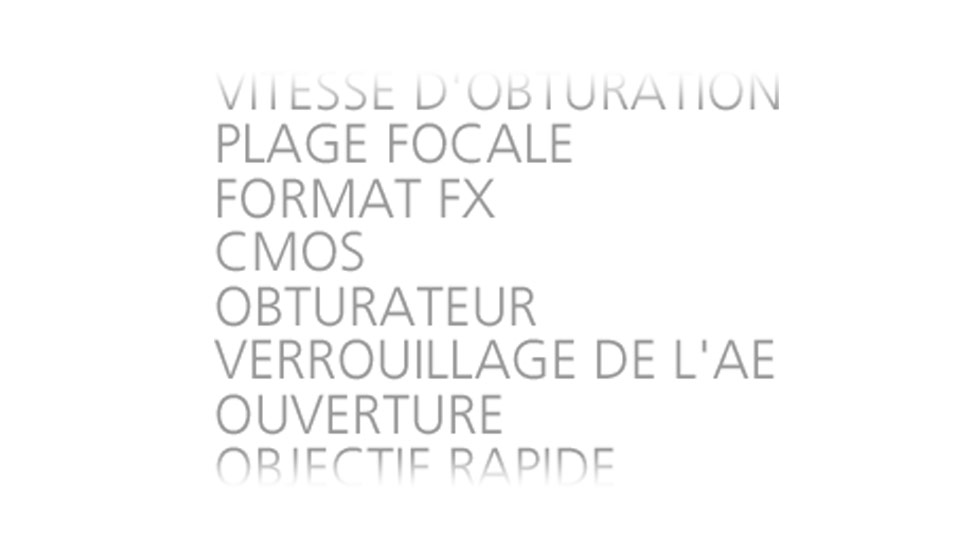Tips for taking great whale and dolphin photos
Adult female humpback whale and calf swim together off Cape Cod, Mass. D750, AF-S NIKKOR 28-300mm f/3.5-5.6G ED VR at 122mm focal length, 1/640 second, f/6.3, ISO 100, program exposure, Matrix metering
One of the more awe-inspiring sights is to see majestic animals in their natural environment. Nowhere is this truer than viewing whales, those huge mammals of the sea. Whales and even their smaller cousins the dolphins and porpoises can be playful and energetic as they leap high into the air or glide effortlessly through the water. Whales, dolphins and porpoises total 90 species of Cetaceans.
With eco-tourism on the rise, there are more and more locations around the world where you can hop on a boat, travel a few miles out into the ocean and see lumbering humpbacks or other types of whales cutting through the waves.
Whales can be found in all of the world’s oceans, off the coasts of every continent. Of the various species of whales, the more common ones you might see include Humpback, Orca, also known as killer whales, Finback, Pilot, Minke and Right whales. If you travel to certain locales you might even spy Gray, Blue and Sperm whales. Go to the Arctic and you might see Beluga, Narwhal and Bowhead whales.
There may be a season when whales and dolphins/porpoises will be more common in the waters near where you live as many of them do migrate each year but it’s easy enough to go onto the internet and do a little research to find out when whales will be in your area.
Flukes of a humpback whale diving under the water with Coney Island, NY in the distance. D750, AF-S NIKKOR 200-500mm f/5.6E ED VR at 500mm focal length, 1/2500 second, f/6.3, ISO 320, program exposure, Matrix metering
Also, be aware that whales are protected in US waters, so boats and swimmers may not come within 100 yards of a whale. The whale can swim near you but you can’t invade its space. Reputable whale watching boat captains will explain that when they’re within close range of these animals, they’ll slow or cut their engines completely so as not to come into physical contact with them. They also should not be chasing a whale or pod of dolphins/porpoises through the water.
Photo Tips:
If you’re going out “whale watching” or live in an area where you can see whales, dolphins or porpoises from the beach, you’re lucky enough in that you’ll be able to take breathtaking photographs and video of these amazing creatures.
To be able to get great photos, worthy of sharing on social media or printing to hang on your walls, you’ll want to use a camera. The camera on your smartphone likely won’t allow for the telephoto reach you may need—or a fast enough shutter speed to freeze action.
You can use any type of camera to take great photos of whales and dolphins/porpoises—from a Point & Shoot like the COOLPIX cameras to the Z series mirrorless or DSLR cameras with a relatively long telephoto NIKKOR zoom lens. The longer the telephoto, the better. For P&S cameras, a bridge zoom is a better option because of the long focal length ranges these cameras feature.
Lens:
Your choice of lens is the most important decision you’ll make when it comes to being able to fill the frame with your subject.
You’ll want to use a zoom lens, because you never know when the wildlife will decide to check out the boat you’re in or come close to shore. Some options to think about: a focal length range of around 55-200mm, 70-300mm, 28-300mm all the way up to the 200-500mm lens.
When using a Nikon full frame (FX) camera, you can manually set the camera to DX shooting mode and that will give you a 1.5x crop factor which will effectively give you a little bit more zoom reach. Nikon cropped sensor cameras (DX) automatically add the 1.5x crop factor onto the focal length of a lens. For example, using the 200-500mm lens on a DX camera or on an FX camera in DX mode will give you a zoom range of 300-750mm.
You may end up doing a lot of your shooting at the telephoto end of the lens, but don’t discount the wider end of the zoom which you can use to show the breadth of the ocean and the animals who live there.
Settings:
Vibration Reduction
If you’re using a VR (Vibration Reduction image stabilization) built-in lens on your DSLR, you’ll want to turn ON the VR. If your lens also gives you the option of selecting from Active or Normal and you’re taking pictures from a boat set the VR setting to Active. This compensates for the movement of the boat. If you’re on the shore, you can leave the setting on Normal.
The Z series full-frame cameras have VR built into the camera bodies which supports all S-line Z lenses and if you're using a non-VR F-mount NIKKOR lens on your Nikon Z with the Mount Adapter FTZ you can enjoy all of the benefits of VR technology.
Exposure
If you want the camera to do the heavy lifting for you—meaning you don’t want to have to think about settings, set the camera to Sports Mode if it has Scene Modes. If it doesn’t have any Scene Modes, set the camera to Auto.
If you’re comfortable setting the exposure manually go ahead and do so; or use shutter priority in which you set the shutter speed and the camera selects the appropriate aperture. You’ll want to use a relatively fast shutter speed to be able to freeze the action of whales feeding or breaching, slapping their tails or pectoral fins on the water. Set the shutter speed for 1/500 or faster.
Using a smaller aperture will give you more depth of field in your images.
If you’re setting your exposure manually, set the ISO high enough for the available light to allow you to use the shutter speed and aperture combination you want to freeze the action.
If its cloudy, and the sun is often breaking through the clouds and then disappearing again set the camera to Auto ISO. The camera will adjust the ISO based on the amount of light and readjust when the sun is obscured and the light level drops.
White Balance
For white balance, set the camera to Auto or if its sunny to Direct Sunlight; similarly, if its cloudy or overcast set it to Cloudy.
Shooting Mode
Set the camera to Continuous shooting mode (AF-C) to track your moving subjects. If the camera you’re using lets you choose between Continuous High or Continuous Low framing rates and you’re photographing a lot of action or are afraid you’ll miss a great shot and want to capture as many frames as the camera will record, set it to Continuous High. Remember though, that when you're in Continuous shooting mode you can keep your finger on the shutter button and the camera will keep shooting until it fills the buffer, so make sure you have plenty of media cards if you’re going to shoot in this manner. A split second can make the difference between a great shot and a not so great shot. Same for extra batteries if you have them.
Focus Points
When it comes to selecting the number of focus points, if you don’t have experience shooting action, start with Dynamic Area AF. If your camera offers Dynamic Area AF with 72 AF points, choose it. Nikon DSLRs, depending upon the model, may offer 9, 11, 21, 39, 51, 72 or 153 AF points. In any case, try to select the highest number of AF points available in your camera. Group Dynamic Area AF is another option, as is Group Area AF. Nikon Z series cameras can offer up to 435 AF points, depending upon the model.
In all the excitement and action, try to remember the rules of photographic composition for pleasing images. Humpback whale’s flukes just above the water’s surface. This image utilized the Rule of Thirds. D5, AF-S NIKKOR 200-500mm f/5.6E ED VR at 500mm focal length, 1/640 second, f/6.3, ISO 100, Shutter Priority, Matrix metering
ID that whale
Try to capture close up shots with only the whale’s flukes (tail) in the frame, but also zoom out and compose photos that include the shoreline if it is visible, or the horizon if you’re in the middle of the ocean. There may be seabirds flying around, following the whales, in the hopes they’ll get a tasty snack of fish left behind so try to capture some of them in the frame as well.
Speaking of whale flukes, they’re as unique to a whale as a fingerprint is to a human. Photographing the flukes is how researchers identify whales. So, you’ll want to get a good shot of the flukes. Another favorite shot that photographers try to capture is one of the flukes as the whale is traveling back down under the water—with water streaming off.
Humpback whale breaching in the NY Bight. D5, AF-S NIKKOR 200-500mm f/5.6E ED VR at 200mm focal length, 1/800 second, f/7.1, ISO 100, Shutter Priority, Matrix metering
Composite of six frames of a humpback whale breaching. D5, AF-S NIKKOR 200-500mm f/5.6E ED VR at 200mm focal length, 1/800 second, f/7.1, ISO 100, Shutter Priority, Matrix metering
Freezing action in mid-air
For great photos of dolphins and porpoises, you’ll want to freeze the action of the animal in mid-air, as they jump (or bow) out of the water. Spinner dolphins will spin as they jump. Sometimes dolphins will try to keep up with a moving boat, leaping repetitively. Again, setting the camera to continuous shooting mode will help you get the shot. Dolphins are very social animals, and travel in pods (groups). If you’re lucky you’ll capture adult females along with their calves.
Breaching whales and those performing tail or pectoral fin slapping make for exciting images so it’s important to use a fast shutter speed so your captures are sharp.
Video
Most Nikon cameras can capture video as well as still images so you might also want to shoot some video of the action.
Regardless of the type of camera you use, photographing whales, dolphins and porpoises can become addicting and you’ll find yourself wanting to get down to the beach or on the water again and again to capture the beauty of these gentle creatures.
Dolphins frolic in the surf off Rockaway Beach, NY. D750, AF-S NIKKOR 200-500mm f/5.6E ED VR at 500mm focal length, 1/2000 second, f/5.6, ISO 320, program exposure, Matrix metering
Typical whale behaviors
There are a variety of whale behaviors that you might witness while out whale watching so we thought we’d explain what some of the more common ones are.
Lunge feeding: when the whales charge (usually upwards from below the water) with an open mouth to feed on a bait ball (a densely compacted grouping of fish—normally bunker—that whales such as humpbacks feed on).
Bubble Net feeding: a group of humpback whales circle the school of fish below the water, exhaling and creating bubbles, trapping the fish within the bubbles. Then they lunge upwards with their mouths open to feed.
Breaching: The whales launch themselves upward out of the water, sometimes fully clearing the surface and flopping back down causing a large splash.
Tail Slapping: A whale will seem as if its standing on its head, so to speak, slapping its tail flukes against the surface of the water.
Pectoral Fin Slapping: A whale will lie on its side slapping its pectoral fin against the surface of the water.
Blows: Whales exhale air from their blow holes. It might look like it's water spraying in the air, but it’s not. You might see a whale doing this with their blow hole visible above the water, or you may just see the spray of air because the blow hole is just below the surface of the water.





























